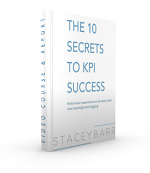What is the ROI on KPIs?
by Stacey Barr |Measure Up reader, Paul O, asks: How do I educate my clients (and win new ones) in SMB of the power and ROI behind great KPIs?
We can easily forget that performance measurement isn’t about filling up the KPI column in the strategic plan. It’s not a bureaucratic hoop to jump through. Performance measurement, when it’s done well, makes a very important difference.
When we are deliberate about measuring what matters, and measuring it well, we reach our goals sooner and with less effort. We can routinely get returns on our investments (ROIs) of a hundred times or more. This means that when we invest time and money (and time is money) in making changes to our business, those changes generate returns (usually cost savings or revenue increases) that are a hundred times more than the investment.
In fact, the ROI we do get on our improvement initiatives is a good measure of our maturity with performance measurement. That’s the essence of the following model:

As the model above suggests, the better we get at measuring performance, the more meaningful targets we can reach. The better we get at reaching meaningful targets, the greater return we get on our improvement initiatives. Getting the results that matter for the least effort is exactly what a high-performance organisation is. And that’s exactly the difference that good performance measurement makes.
No idea?
Having no idea what the ROI is on your initiatives is the worst way to be. It means you’re making investments like playing poker with a blindfold on. It’s all luck, and more bad that good. Your only choice is to take the blindfold off by measuring.
Going backwards
When you actually know that your investment in improvement initiatives is costing you more than you’re gaining, you have choices. You can withdraw your investments from dying initiatives, or you can fix the initiatives. Turn the momentum around with a few quick wins driven by good measures.
Ad hoc or random
When you don’t have systematic approach to measuring what matters, you can at best expect to have a few modest ROIs here and there. To get better, you’ll need to nurture a culture of measurement and continuous improvement.
Some targets
When you start taking targets more seriously, you start reaching some of them, and getting some respectable ROIs. Taking targets seriously means measuring the right things, finding out your baseline, and setting targets that make sense given your baseline and the resources you’re willing to invest in improvement. This takes capability, because good measurement and target setting are not natural skills.
Most targets
When you have the ability to reach most of the (meaningful, not trivial) targets you’re setting, it shows you have a pretty good handle on the capability of your business processes. You’ve learned enough about how they work and what constrains them, and so you get very respectable ROIs. Here, your job is to integrate the approach of performance measurement so it becomes “just how we do things around here”.
All targets
All targets? Really? Well, virtually all of them. When you reach just about every target you set (and assuming you’re not setting easy-peasy trivial targets and you’re not setting demoralisingly-vast stretch targets), you know what matters and how to stay focused on it. You’re now looking for leverage, to find the easiest ways to get the biggest gains in the fewest things that matter.
Can you think of exceptions to this model? Of course you can. No model is perfect. Models aren’t supposed to be perfect. They’re supposed to be useful. And the use in this KPI ROI model is to make your pursuit of high-performance deliberate.
DISCUSSION:
If you knew it would take another five years for your organisation to truly have a high-performance culture, what would you start doing now?
Connect with Stacey
Haven’t found what you’re looking for? Want more information? Fill out the form below and I’ll get in touch with you as soon as possible.
167 Eagle Street,
Brisbane Qld 4000,
Australia
ACN: 129953635
Director: Stacey Barr




